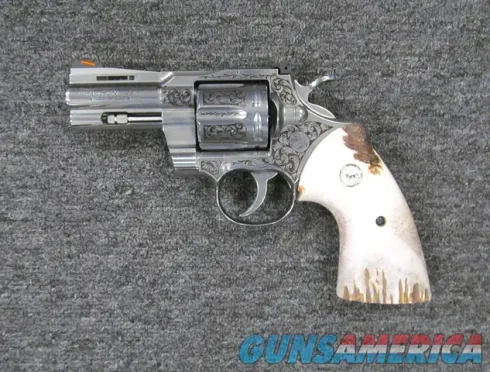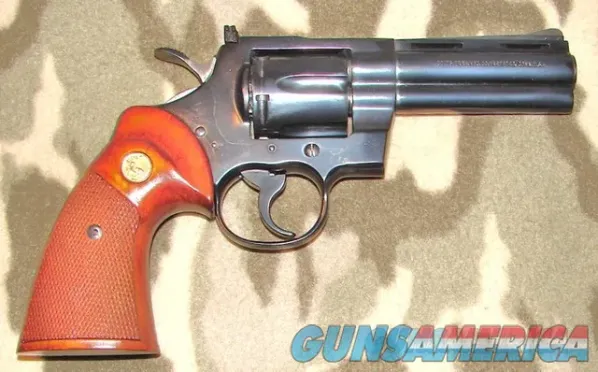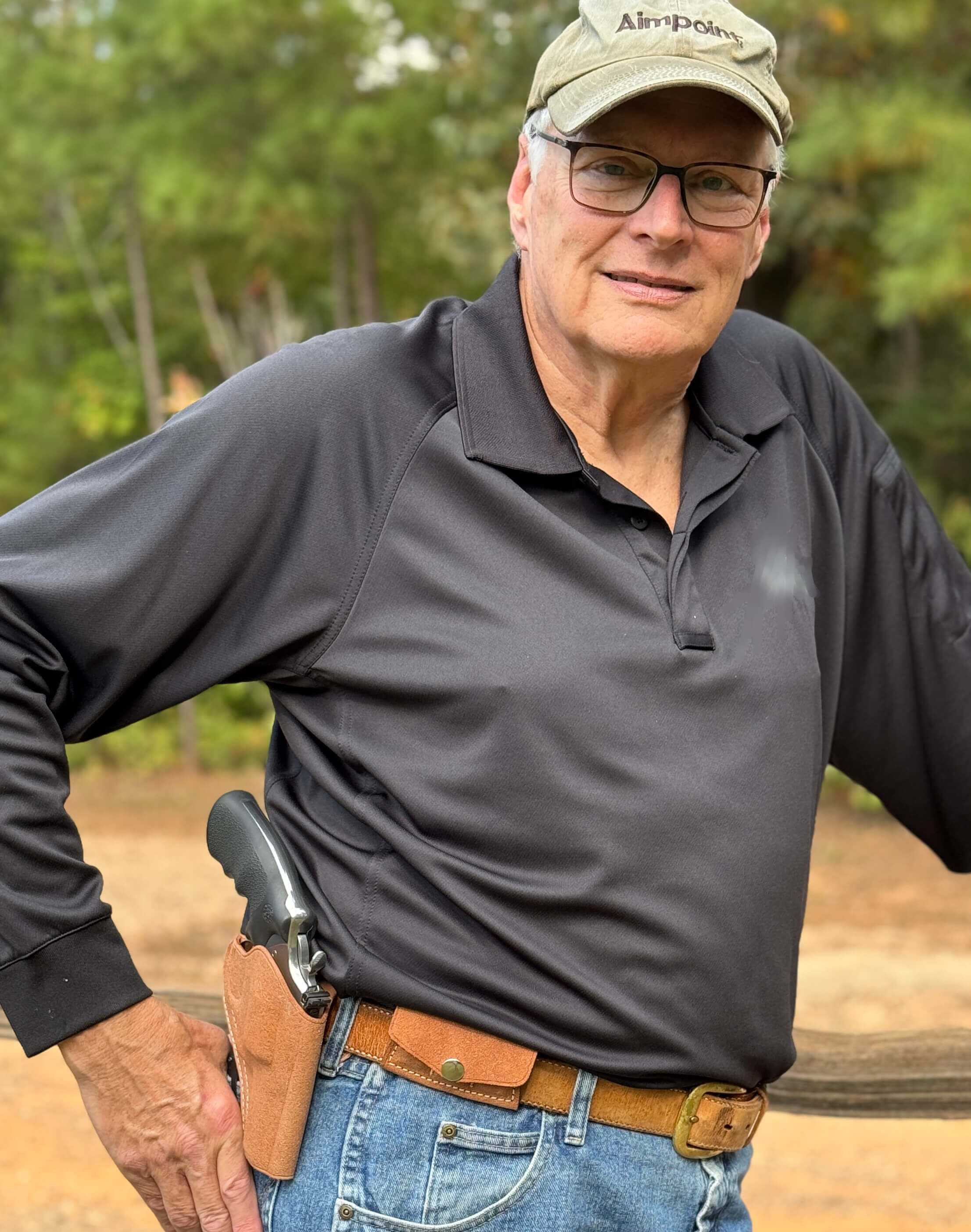
Estimated reading time: 14 minutes
Don’t look now but it seems that Colt Firearms is determined to take over the revolver market! In the past four years, they have launched a new generation of wheelguns starting with the Python in 2020. Current offerings include the Cobra, King Cobra, Python, and Anaconda. The newest snake to be resurrected. is the Viper.
Table of contents
Based on the D-size frame, the original Viper was only made in 1977, with a reported production of only 4,000 guns. Those guns were all made on an alloy frame, as were the Colt Cobras. Unfortunately, they were quickly discontinued and now bring collector’s prices.
Available on GunsAmerica Now
The New Heavy-Weight Viper
Introduced in May of 2024, the Viper shares the same stainless steel construction and frame as the King Cobra. Both are D-size frames, have a six-shot capacity, and are chambered in .357 Magnum. The Colt Viper is available in either a 4.25” or a 3” barrel. As with the other “Snake” guns, the Viper makes extensive use of modern manufacturing technology that allows parts to be made with higher tolerances. This eliminates most of the hand fitting, thus improving quality without increasing labor costs.
The main difference between the Viper and the King Cobra is the barrel profile. Instead of a full underlug, the Viper has a “half-lug” that reduces weight and bulk. It is a very sleek little pistol.
Unboxing our test pistol, I was impressed with the fit and finish that Colt continues to produce. The stainless frame and barrel are evenly polished to an almost nickel finish. The pistol is void of any machine marks or external flaws in the finish. The top strap and top of the barrel have a matte finish to reduce glare for an improved sight picture.
Features



Some people have commented on the oddly shaped trigger guard. Colt explained that it allows for a longer trigger to improve the pistol’s action. I appreciated that the Viper comes with a smooth face trigger instead of the serrated triggers found on the Python and the Anaconda. The edges of the trigger are nicely radiused and the trigger measures approximately 7/32” at the bottom. Even though the Viper uses a leaf spring, the double action has minimal stacking. Using my Lyman Electronic Trigger gauge, I found the Viper averaged a 9 lb. double action and a 3 lb. 12 oz. single action. The pull was smooth without any grit or play.
Stocks and Sights
The stocks on the Viper extend past the frame and provide a full gripping surface for most shooters. They fit the frame relatively well and fill the sinus behind the trigger guard to reduce “knuckle bump.” The checkering and contour at the top of the stocks are reminiscent of the 1980s Detective Specials and Cobras. The sides are nicely checkered and the grain is attractive.
The Viper’s sights consist of a fixed square notch rear and black serrated front ramp. As with other Colt revolvers, the front sight is retained by a single set screw and is easily replaced by the user. This feature was key during our evaluation.


Range Time With the Viper
We hit the range with an assortment of ammunition that ranged from a Hornady’s Critical Defense Lite 90 gr. FTX .38 Special to a full-blown Hornady .357 Magnum 125 gr. load. For formal testing, I selected the following loads that I felt were the most applicable.
| Colt Viper Range Testing | |||||
| Manufacturer | Caliber | Bullet | Average | Accuracy | |
| Hornady Critical Defense Lite | .38 Special | 90 gr. FTX | 1,026 fps | 1.5” | |
| Hornady Critical Defense | .38 Special | 110 gr. FTX | 979 fps | .75” | |
| Federal Punch | .38 Special +P | 120 gr. JHP | 1,053 fps | 1.9” | |
| Hornady Critical Defense | .357 Magnum | 125 FTX | 1,356 fps | 2.75” | |
| Velocity measured at the muzzle with a Garmin Xero C-1 Pro Chronograph | |||||
| Accuracy fire off-hand at 10 yards | |||||

The Hornady Critical Defense Lite is designed to have reduced recoil by using a lighter projectile that is driven at a higher velocity. Recoil was reasonably mild but the loads shot approximately 3” high at 10 yards. The Critical Duty 110 gr. FTX is a proven performer that finds the sweet spot between bullet weight and velocity. Federal’s Punch .38 +P load features a 120-grain jacketed hollow point. While a little hot, Punch had shown consistent performance in all my tests.
The Viper handled all, but the .357 Magnum load, well. Recoil and muzzle flip was pretty violent and follow-up shots were difficult. I certainly could not have made the par times on a 5x5x5 drill. (5 shots/5 seconds/5 yards shot on a B-8 bullseye target. Magnum loads are just brutal and I would not recommend them.

Performance
Working on the range brought out two issues with the Viper. The first is that the left stock panel routinely prevents a clean ejection of all six empty cases. That is a significant issue with a personal defense revolver. I anticipated that the contour of the stocks, large at the base and narrowing at the top strap, would create an issue with recoil control. I found this issue with the three Pythons I have tested. I was pleasantly surprised that I did not have that issue with the Viper. That was, in part, due to the sharper contour to the bottom of the stocks and how the stocks fill the sinus behind the trigger guard. However, the reloading issue needs to be corrected.
The other issue I found was that I had extreme difficulty finding the front sight, especially when shooting on a black B-8 target. In bright sun, this was exasperated by the glare from the rear of the frame, below the rear sight aperture. Fortunately, this was an easy fix. I contacted my good friend John Harrison, of Harrison Design. John has a complete line of Harrison Design Snake Sights for all of the Colt double action Snake revolvers. John sent me an improved ramp front sight blade that had a green Ameriglo tritium lamp and a Lumi-green ring. This single change significantly improved my performance with the Viper.



Colt Viper Accuracy
I shot the HiTs Super Snubby Test which consists of 5 rounds, fired from 3, 5, and 10 yards respectively. Par time for each string of fire is 3 seconds, 5 seconds, and 8 seconds respectively. The 3-yard line is fired using the strong hand only, so 5 shots in 3 seconds is spicy. The drill is normally shot on a B-8 repair center and scored using the ring values on the target. However, I did not have any B-8 targets so I shot it on a NRA qualification target. I shot the test using High Desert Cartridge Company’s plated 148 grain wadcutter.
Later, I superimposed the target on a B-8, to get a proper score. I shot a 142/150 with three X-ring hits. I did bust the 3-yard line time by .62 seconds. That penalty reduced my score by 2 points giving me a 140, or 93%. I only shot the drill one time. I can say that I could not have achieved this score without the Harrison front sight blade.

For giggles and grins, I placed an IDPA silhouette target at 45 yards. From a bench rest, using High Desert .38 TMJ load, I was able to score three “A” zone hits and two “B” zone hits. I threw one shot completely off target. All shots were fired in double action. For a medium size revolver, with fixed sights, I was pretty impressed with the Viper.
Duty Ammunition Testing
We shot all four loads into a previously used Clear Ballistics 10% FBI gel block. The rounds were shot into bare gel and into gel through four layers of denim. While time-consuming, the test provided us with some solid data. The table below reflects the results of the gel tests.
| Colt Viper Ballistic Gel Test | |||||||
| Bare Gel | 4 Layers Denim | ||||||
| Manufacturer | Caliber | Bullet | Avg. Penetration | Average Expansion | Avg. Penetration | Average Expansion | |
| Hornady Critical Defense Lite | .38 Special | 90 gr. FTX | 13.3” | .46” | 19.1 | None | |
| Hornady Critical Defense | .38 Special | 110 gr. FTX | .13.8’ | .45” | 15.6” | .45” | |
| Federal Punch | .38 Special +P | 120 gr. JHP | 14.3” | .55” | 18” | .41” | |
| Hornady Critical Defense | .357 Magnum | 125 FTX | .22.5” | .55” | 25.75 | .38” | |
The biggest surprise was the penetration of the 90 gr. Hornady Lite. The penetration was consistent and, in bare gel, it expanded as well. I would note that during bullet expansion, the FTX bullet tends to roll back over the lip of the projectile. It does not produce “flower-like petals” like some other loads. Still, the 90 gr. FTX expanded to an average of 32% over its original diameter. As expected, when fired through four layers of denim, the projectiles did not expand and, most of the time, the projectile inverted and came to rest base first.
Critical Defense

The Critical Defense 110 FTX is probably Hornady’s .38 Special load for personal defense. This load was very consistent in both penetration and expansion in bare gel. In the all stainless steel Viper, the recoil was very manageable. Expansion through the denim was inconsistent. Two rounds expanded with irregular jacket deformation. One round failed to expand and still had the red polymer plug intact. This is similar to what I have observed in other tests. The 110 FTX is an ideal round for the most personal defensive situations.

Federal 120 gr. Punch
The Federal 120 gr. Punch was the most impressive. In bare gel, the projectile expanded by .57% of its original diameter. The jacket peeled back completely and the lead core expanded to an average of .55”. When shot through the denim, two rounds expanded while one round failed to expand and inverted at the end of the cavity. I would certainly consider Punch as a carry load for shooters that are not recoil-sensitive.

While I really didn’t want to shoot Magnum loads through the Viper, I knew that I needed to just suck it up! The Hornady Critical Defense load is a 125 gr. FTX projectile. I was very interested in how it would perform at an average velocity of 1,356 fps. When shot through the bare gel, the two recovered rounds penetrated 26” and 19” respectively. One round was lost out of the side of the gel block. The two recovered rounds fully expanded down to the base of the base of the cavity. When shot through the denim, the rounds deformed in a very inconsistent manner. The jackets were torn and, in one case, the round collapsed into itself.
Clearly, the combination of the bullet construction, the high velocity, and the denim was disruptive to performance. As previously stated, Magnum loads are pretty brutal in the Viper and I would not suggest punishing the revolver or the shooter’s hand by shooting these loads.


Final Thoughts On the Colt Viper
While I was impressed with the Viper, I was not surprised. After having evaluated several Pythons, a King Cobra, and an Anaconda, I knew the quality of the revolver that Colt is producing. If I were carrying the Viper, I would swap the stocks out for a set of rubber Hogue stocks, similar to those that ship on the King Cobra guns. The Harrison replacement front sight is an absolute necessity. Other than those two issues, I find the Viper to be a superb medium-frame revolver. It is sleek and very capable of protecting you and your loved ones.
READ MORE: What Is The 327 Federal Magnum Good For?
Once again, Colt has hit a home run and continues to set the standard for defensive revolvers, proving the revolver is alive and well in 2024, and beyond!
*** Buy and Sell on GunsAmerica! ***












What is the QR code on the right side of the frame for?
Looks reminiscent of the Colt Police Positive, except the positive was sleeker, less chunky.
As a Florida Security Officer, we were required to carry 38 Special, on our strong side, at the belt line.
A perfect score was 240, but when I qualified with my police positive, I got a 240, with 23X. There was a group on both targets, the size of the palm of my hand, shot from 25, 15, 7, and 1 yard. It was the only year I used that one, and the best score I’d personally gotten.
3 times the price of a Taurus look alike? How much more accurate is it when compared to a Taurus?
I am a gunsmith and gun dealer. When I tried to order Colt handguns from distributors, they are required by Colt to get all kinds of data from us including photos of my business. I see it this way: Colt does not want my business. Now I will only be buying S&W, Ruger, Glock, Sig, etc., firearms. Who needs Colt? Be well and stay safe. j
$1,000 for a revolve. No thanks
Sorry, but I will never go to a Colt revolver, shot them, don’t like’em!
I’m a Smith & Wesson man and always will be!
Oh and you can take the .357 Magnum and shove it where the sun doesn’t shine!
Everyone knows revolvers are dead. The Glock Lickers said so.
Channeling it’s inner S&W Model 19?
Looks like to me that every single load you tried was a complete failure. I don’t think I’d agree with recommending even the Federal Punch. A bullet that works in bare gel but fails with a clothing barrier is a bullet that’s not worth carrying in my opinion due to being completely unpredictable. Seems like more testing is needed or switch to a semi wadcutter/wadcutter. If I remember correctly, Sam from “Gun Sam Revolver Aficionado” on YT, has tested the .38 Special quite a bit and found some commercial loads that work well.
Exacerbated
Glad I’m not the only one to catch that.
Well that problem with the grip/ejector is a deal breaker. How could they miss that? Or did they just shrug it off? Also, in this day and age, it seems a bit too cheap to use plain black sights on a defensive revolver. I would trade the fancy grips for a shiny spot on that front sight.